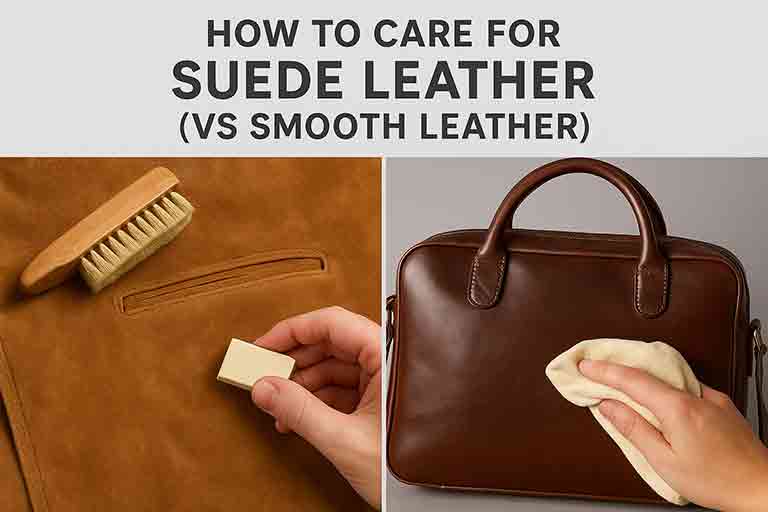
How to Care for Suede Leather (vs Smooth Leather)?
, by Syed Khawar Bukhari, 7 min reading time

, by Syed Khawar Bukhari, 7 min reading time
Caring for suede leather requires a unique approach that differs significantly from maintaining smooth or full-grain leather. Both materials are luxurious and durable, but their textures, finishes, and reactions to moisture or dirt are distinct. Understanding these differences ensures your leather garments, bags, and accessories remain in pristine condition for years.
Before exploring care routines, it’s crucial to understand what sets suede apart from smooth leather.
Suede is created from the underside of animal hide, typically cow, calf, goat, or lamb. This process produces a soft, napped surface with a matte finish that feels luxurious to touch. Its porous texture, however, makes it more susceptible to stains, moisture, and scuffing.
Smooth leather—often full-grain or top-grain—comes from the outer side of the hide. It retains the natural grain and offers a glossy or semi-glossy appearance. This leather type is more resilient against water and wear, making it easier to clean and condition.
Proper maintenance begins with having the right tools on hand. Whether it’s suede or smooth leather, investing in quality products helps extend the lifespan of your items.
Soft-bristled suede brush: To lift dirt and restore the nap.
Suede eraser or cleaning block: For removing stubborn marks and stains.
Protective spray: A water- and stain-repellent designed for suede.
Microfiber cloth: Ideal for buffing and polishing smooth leather.
Leather conditioner: Essential for keeping smooth leather supple.
Shoe trees or stuffing: To maintain the shape of leather shoes or bags.
Cleaning suede demands a gentle touch and patience. Here’s a complete process to help you keep suede looking immaculate.
Use a suede brush to gently remove any dust or debris. Always brush in the same direction to preserve the nap. For more stubborn dirt, use a back-and-forth motion with light pressure.
For dry stains, rub gently with a suede eraser or a clean white pencil eraser. For wet stains, blot immediately using a dry cloth—never rub, as this can spread moisture deeper into the fibers.
After cleaning, brush the suede again in one direction to restore its signature velvety texture. A light steam treatment can also help lift flattened fibers.
Finish with a suede protector spray to repel water and stains. Apply in a well-ventilated area, and let the item dry completely before wearing or using it again.
Smooth leather, though more forgiving than suede, still benefits from regular maintenance to prevent cracks and fading.
Use a damp microfiber cloth to remove surface dust or grime. Avoid soaking the leather, as excess water can lead to discoloration or warping.
For deeper cleaning, apply a pH-balanced leather cleaner using circular motions. This removes embedded dirt and helps preserve the finish without stripping natural oils.
After cleaning, apply a leather conditioner evenly using a soft cloth. Allow it to absorb for 10–15 minutes, then buff with a dry cloth to achieve a natural sheen.
For certain smooth leathers like patent or dress shoes, a neutral or color-matched polish enhances luster and creates a protective barrier.
| Aspect | Suede Leather | Smooth Leather |
|---|---|---|
| Texture | Soft, napped surface | Smooth, glossy finish |
| Moisture Sensitivity | Highly absorbent | More water-resistant |
| Cleaning Method | Dry brushing and erasing | Wiping and conditioning |
| Protection | Suede spray | Leather conditioner |
| Storage | Breathable bag, away from light | Dust bag or box with ventilation |
Suede requires dry cleaning methods, while smooth leather thrives on moisture-based conditioning. Mixing these techniques can damage the material, so always tailor your approach to the specific leather type.
Water stains can be particularly frustrating for suede owners. To minimize their impact:
Dampen the Entire Area Lightly: Even out the moisture across the panel using a slightly wet cloth.
Let It Dry Naturally: Avoid heaters or sunlight, as these can harden or discolor suede.
Brush the Nap: Once dry, use a suede brush to restore texture and remove any remaining marks.
For oil-based stains, sprinkle cornstarch or talcum powder and let it sit overnight to absorb grease before brushing it off.
Both suede and smooth leather benefit from proactive care. Follow these best practices to extend their life and appearance:
Store in cool, dry places away from direct sunlight or humidity.
Avoid plastic covers that trap moisture—opt for breathable fabric dust bags.
Use shoe trees or acid-free paper stuffing to maintain shape.
Alternate wear to prevent overuse and allow leather to breathe.
Reapply protective coatings every few months for maximum defense.
Sometimes, DIY care isn’t enough. Deep oil stains, mold, or color fading may require professional leather restoration services. Experts can:
Re-dye faded suede or smooth leather.
Replace worn linings or zippers.
Recondition severely dried-out material.
Provide specialized waterproofing treatments.
Investing in professional care can revive your leather goods and ensure they remain timeless pieces in your wardrobe.
Modern consumers prefer sustainable care methods that protect both their leather and the environment. You can replace harsh chemicals with:
White vinegar or lemon juice (for gentle stain removal)
Baking soda (for odor control)
Natural beeswax conditioner (for smooth leather hydration)
These eco-friendly alternatives not only maintain your leather but also align with conscious living.
Caring for suede and smooth leather is more than maintenance—it’s preserving craftsmanship, texture, and heritage. Each type requires a distinct routine: suede demands gentleness and protection, while smooth leather thrives on conditioning and polishing. By mastering both, you ensure your leather accessories, shoes, and suede jackets continue to look refined, elegant, and enduring through every season.


